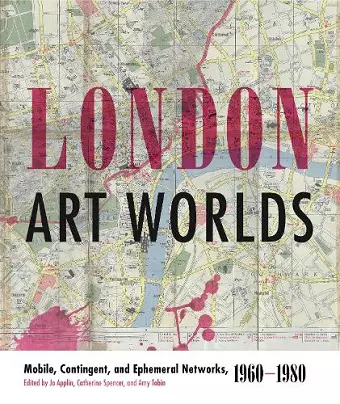London Art Worlds
Mobile, Contingent, and Ephemeral Networks, 1960–1980
Amy Tobin editor Catherine Spencer editor Jo Applin editor
Format:Paperback
Publisher:Pennsylvania State University Press
Published:20th Jan '20
Currently unavailable, and unfortunately no date known when it will be back
This paperback is available in another edition too:
- Hardback£103.95(9780271078533)

The essays in this collection explore the extraordinarily rich networks of international artists and art practices that emerged in and around London during the 1960s and ’70s, a period that saw an explosion of new media and fresh attitudes and approaches to making and thinking about art.
The contributors to London Art Worlds examine the many activities and movements that existed alongside more established institutions in this period, from the rise of cybernetics and the founding of alternative publications to the public protests and new pedagogical models in London’s art schools. The essays explore how international artists and the rise of alternative venues, publications, and exhibitions, along with a growing mobilization of artists around political and cultural issues ranging from feminism to democracy, pushed the boundaries of the London art scene beyond the West End’s familiar galleries and posed a radical challenge to established modes of making and understanding art.
Engaging, wide-ranging, and original, London Art Worlds provides a necessary perspective on the visual culture of the London art scene in the 1960s and ’70s. Art historians and scholars of the era will find these essays especially valuable and thought provoking.
In addition to the editors, contributors to this volume are Elena Crippa, Antony Hudek, Dominic Johnson, Carmen Juliá, Courtney J. Martin, Lucy Reynolds, Joy Sleeman, Isobel Whitelegg, and Andrew Wilson.
“The essays examine diverse practices, including interactive installation and environmental art, offering instructive discussion of intersections between art, feminism, and film and of the evolution of the London art scene in the 1960s–70s. Recommended.”
—C. J. Jolivette Choice
“The volume is bound to become an essential resource for anyone working in the field of twentieth-century British art, including those with a special interest in the continued development of sculpture in the context of the dematerialization of the art object. What is more, the book will undoubtedly prompt further research into the rich artistic worlds it maps out. I, for one, am thrilled by this prospect.”
—Giulia Smith The Sculpture Journal
“The sixties—less so the seventies—is a crowded field, but this original and provocative collection challenges received wisdom on the period. It casts new light on work by women artists and filmmakers; on conceptual, performance, feminist, and other kinds of politicized and often collaborative activity; on the increasingly international traffic in artists and ideas; and on a counterculture unfolding across two decades from the Britain of Harold Wilson to the emergence of Margaret Thatcher.”
—Lisa Tickner, author of Modern Life and Modern Subjects: British Art in the Early Twentieth Century
“The fascinating episodes recounted in London Art Worlds expand, deepen, and complicate what we mean by the art history of the 1960s and 1970s—whether in the capital, across Britain, or on an international stage.”
—Thomas E. Crow, author of The Long March of Pop: Art, Music, and Design, 1930 to 1995
“London Art Worlds is a fresh and original rethinking of experimental art practices of the 1960s and 1970s produced in Britain that provides an important supplement to critical postcolonial studies of the period. The London that emerges is not the complacently assumed center of the former empire, but a contingent site for a new set of global networks and a sometimes temporary home for a diverse range of artists who may or may not claim Britishness.”
—Siona Wilson, author of Art Labor, Sex Politics: Feminist Effects in 1970s British Art and Performance
ISBN: 9780271078540
Dimensions: 241mm x 203mm x 18mm
Weight: 907g
248 pages